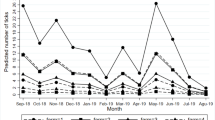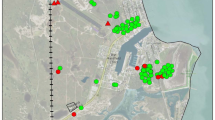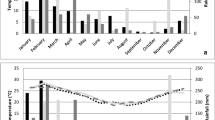Abstract
Given the difficulties of controlling the tick Rhipicephalus microplus due to acaricide resistance, this study aimed to ascertain whether shearing could reduce infestation in cattle. 17 taurine cattle were sheared on the anterior third of one randomly selected side. Shearing was undertaken using a machine with a blade, leaving coats with a thickness of 1 mm. Subsequently, eight evaluations were performed once a week, counting adult females of R. microplus with a diameter > 4.5 mm on the anterior third of both sides (shorn and unshorn). The coat length was also monitored by taking five hair samples from each animal fortnightly (1, 15, 29, 43 and 57 days post shorn) from a central area of both shoulders (shorn and unshorn). The tick counts and hair length data were transformed for normalisation and were analysed using mixed models. The tick and hair length means were significantly higher for the unshorn side. Tick counts were significantly lower on the sheared side until the fifth evaluation, with the final three presenting no differences between the sides. The hair length was significantly lower for the sheared side during the five evaluations. We conclude that as the hair length increased, there was also an increase in the number of ticks on the sheared side. Although this method is not practical for large herds, it can be deemed an option in extreme conditions of tick infestation. In addition, the study reinforces the suggestion that the selection and/or use of cattle with shorter hairs may contribute to reduced tick infestation.

Similar content being viewed by others
References
Allen NN, Dicke RJ (1952) Cattle lice control by clipping. J Econ Entomol 45(6):970–973
Allen TE, Bennett JW, Donegan SM, Hutchinson JCD (1970) Moisture, its accumulation and site of evaporation in the coats of sweating cattle. J Agric Sci 74:247–258
Bennett GF (1969) Boophilus microplus: experimental infestations on cattle restrained from grooming. Exp Parasitol 26:323–328
Bonsma JC (1949) Breeding cattle for increased adaptability to tropical and subtropical environments. J Agric Sci 39:204–221
Colwell DD, Dantas-Torres F, Otranto D (2011) Vector-borne parasitic zoonoses: emerging scenarios and new perspectives. Vet Parasitol 182:14–21
Dikmen S, Khan FA, Huson HJ, Sonstegard TS, Moss J, Dahl GE, Hansen PJ (2014) The SLICK hair locus derived from Senepol cattle confers thermotolerance to intensively managed lactating Holstein cows. J Dairy Sci 97(9):5508–5520
Doube BM, Kemp DH (1979) The influence of temperature, relative humidity and host factors on the attachment and survival of Boophilus microplus (Canestrini) larvae to skin slices. Int J Parasitol 9:449–454
Dowling DF (1960) The significance of the coat in heat tolerance of cattle. II. Effect of solar radiation on body temperatures. Aust J Agric Res 11(5):871–874
Fagnani R, Battaglini APP, Tamanini R, Seixas FN, Beloti V (2011) Análise de risco de praguicidas em leite cru e caracterização do uso em propriedades leiteiras. Rev Inst Latic Cand Tostes 383(66):20–26
Faza AP, Barreto Pinto IS, Fonseca I, Antunes GR, Monteiro CMO, Muniz MS, Martins MF, Furlong J, Prata MCA (2013) A new approach to characterization of the resistance of populations of Rhipicephalus microplus (Acari: Ixodidae) to organophosphate and pyrethroid in the state of Minas Gerais, Brazil. Exp Parasitol 134:519–523
Fraga AB, Alencar MM, Figueiredo LA, Razook AG, Cyrillo JNSG (2003) Análise de fatores genéticos e ambientais que afetam a infestação de fêmeas bovinos da raça Caracu por carrapatos (Boophilus microplus). Rev Bras Zootec 32(6):1578–1586
Grisi L, Leite RC, Martins JRS, Barros ATM, Andreotti R, Cançado León AAP, Pereira JB, Villela HS (2014) Reassessment of the potential economic impact of cattle parasites in Brazil. Braz Vet Parasitol 23:150–156
Hall CA, Martin ICA, McDowell PA (1980) Patterns of wool moisture in Merino sheep and its association with blowfly strike. Res Vet Sci 29:181–185
Hansen PJ (2004) Physiological and cellular adaptations of zebu cattle to thermal stress. Anim Reprod Sci 82–83:349–360
Higa LOS, Garcia MV, Barros JC, Koller WW, Andreotti R (2015) Acaricide resistance status of Rhipicephalus microplus in Brazil: a literature overview. Med Chem 5(7):326–333
Hüe T, Horlin JC, Teurlai M, Naves M (2014) Comparison of tick resistance of crossbred Senepol x Limousin to purebred Limousin cattle. Trop Anim Health Prod 46:447–453
Ibelli AMG, Ribeiro ARB, Giglioti R, Regitano LCA, Alencar MM, Chagas ACS, Paço AL, Oliveira HN, Duarte JMS, Oliveira MCS (2012) Resistance of cattle of various genetic groups to the tick Rhipicephalus microplus and the relationship with coat traits. Vet Parasitol 186(3–4):425–430
Jonsson NN, Matschoss AL, Pepper P, Green PE, Ansell J (2000) Resistance of Holstein-Friesian cows to infestation by the cattle tick (Boophilus microplus). Vet Parasitol 89:297–305
Jonsson NN, Davis R, De Witt M (2001) An estimate of economic effects of cattle tick (Boophilus microplus) infestation on Queensland dairy farms. Aust Vet J 79:826–831
Kemp DH, Koudstaal P, Roberts JA, Kerr JD (1976) Boophilus microplus: the effect of host resistance on larval attachments and growth. Parasitol 73:123–136
Koudstaal D, Kemp DH, Kerr JD (1978) Boophilus microplus rejection of larvae from British breed cattle. Parasitology 76:379–386
Marufu MC, Qokweni L, Chimonyo M, Dzama K (2011) Relationships between tick counts and coat characteristics in Nguni and Bonsmara cattle reared on semiarid rangelands in South Africa. Ticks Tick Borne Dis 2:172–177
O’Kelly JC, Spiers WG (1983) Observations on body temperature of the host and resistance to the tick Boophilus microplus (Acari: Ixodidae). J Med Entomol 20(5):498–505
Riek RF (1956) Factors influencing the susceptibility of cattle to tick infestation. Aust Vet J 132:204–208
Roberts JA (1968a) Acquisition by the host of resistance to the cattle tick, Boophilus microplus (Canestrini). J Parasitol 54(4):657–662
Roberts JA (1968b) Resistance of cattle to the tick Boophilus microplus (Canestrini). II. Stages of the life cycle of the parasite against which resistance is manifest. J Parasitol 54(4):667–673
Roberts JA (1971) Behavior of larvae of the cattle tick Boophilus microplus (Canestrini) on the cattle of differing degrees of resistance. J Parasitol 57(3):651–656
Rodrigues DS, Leite RC (2013) Impacto econômico de Rhipicephalus (Boophilus) microplus: estimativa de redução de produção de leite. Arq Bras Med Vet Zootec 65(5):1570–1572
Salas JH, González MM, Noa M, Pérez NA, Diaz G, Gutiérrez R, Zazueta H, Osana I (2003) Organophosphorus pesticide residues in Mexican commercial pasteurized milk. J Agric Food Chem 51(15):4468–4471
SAS (2002) Statistical Analyses System/Insight User’s Guide, version 9.1.3 for Windows. SAS Institute, Cary, NC, USA
Silva RG (2000) Introdução à bioclimatologia animal. Novel, São Paulo
Silva RG, Arantes-Neto JG, Heltz-filho SV (1988) Genetic aspects of the variation of the sweating rate and coat characteristics of Jersey cattle. Rev Brazil Genet 11(2):335–347
Silva RG, La Scala JRN, Pocay PLB (2001) Transmissão de radiação ultravioleta através do pelame e da epiderme de bovinos. Rev Bras Zootec 30(6):1939–1947
Smith FD, Ballantyne R, Morgan ER, Wall R (2011) Prevalence, distribution and risk associated with tick infestation of dogs in Great Britain. Med Vet Entomol 24(4):377–384
Snowball GJ (1956) The effect of self-licking by cattle in infestations of cattle tick Boophilus microplus (Canestrini). Aust J Agric Res 7:227–232
Turner HG (1962) Effect of clipping the coat on performance of calves in the field. Aust J Agric Res 13(1):180–192
Turner HG, Schleger AV (1960) The significance of coat type in cattle. Aust J Agric Res 11:645–663
Utech KBW, Wharton RH, Kerr JD (1978) Resistance to Boophilus microplus (Canestrini) in different breeds of cattle. Aust J Agric Res 29(9):885–895
Veríssimo CJ, Nicolau VL, Cardoso VL, Pinheiro MG (2002) Haircoat characteristics and tick infestation on Gyr (Zebu) and crossbred (Holstein x Gyr) cattle. Arch Zootec 51(195):389–392
Veríssimo CJ, Bechara GH, Mukai LS, Otsuk IP, Pozzi Arcaro JR (2008) Mast cell counts correlate with Rhipicephalus (Boophilus) microplus tick load in different cattle breeds. Braz J Vet Pathol 1(2):81–87
Veríssimo CJ, D’Agostino S, Pessoa FF, Toledo LM, Miranda Santos IKF (2015) Length and density of filiform tongue papillae: differences between tick-susceptible and resistant cattle may affect tick loads. Paras Vectors 8:594
Wilkinson PR (1972) Sites of attachment of “prairie” and “montane” Dermacentor andersoni (Acarina: Ixodidae) on cattle. J Med Entomol 9:133–137
Acknowledgements
This research project was supported by the São Paulo State Research Support Foundation (FAPESP) (Grant #2012/03191-9) and the Institute of Animal Science (APTA-SAA).
Author information
Authors and Affiliations
Corresponding author
Additional information
Publisher's Note
Springer Nature remains neutral with regard to jurisdictional claims in published maps and institutional affiliations.
Rights and permissions
About this article
Cite this article
Veríssimo, C.J., Giglioti, R., D’Agostino, S.M. et al. Cattle herd shearing can help to control Rhipicephalus microplus ticks. Exp Appl Acarol 79, 99–106 (2019). https://doi.org/10.1007/s10493-019-00413-0
Received:
Accepted:
Published:
Issue Date:
DOI: https://doi.org/10.1007/s10493-019-00413-0




